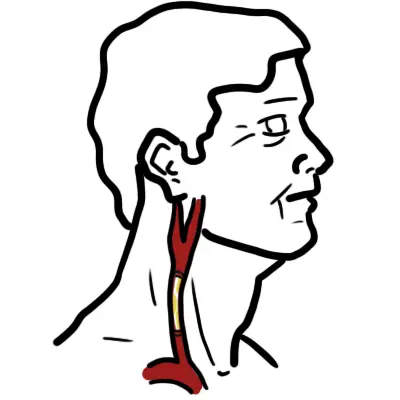Carotid Artery Disease


Stroke is the third leading cause of death and a principal cause of long-term disability in much of the industrialized world. Stroke is often caused by atherosclerotic lesions of the carotid artery bifurcation. 10% of all strokes are due to carotid disease. The degree of internal carotid artery stenosis is the most important predictor of cerebral infarction among patients with extracranial carotid artery disease.
30% of patients who present with suspected stroke have a ‘stroke mimic’ such as tumour, subdural haematoma, migraine, hypoglycaemia, postictal paralysis or cerebral abscess.
Stroke: The development of an acute stroke or transient ischaemic attack is a medical emergency.
Transient Ischaemia attack (TIA): Minor stroke or transient ischaemic attack, characterized as a brief episode of neurologic dysfunction caused by focal cerebral ischaemia without infarction. TIA is characterised by absence of infarction on imaging.
Atherosclerosis: Progressive disease characterized by the accumulation of lipids and fibrous elements in the large arteries (plaque).
Carotid artery stenosis: Typically the result of atherosclerosis at the bifurcation of the common carotid artery or in the origins of either the internal or the external carotid artery.
Carotid body tumour.
Initial mortality of an ischaemic stroke ranges from 15-30%. Survivors remain at a high risk of subsequent stroke (50% of patient will experience a second event in 5 years).
The common carotid artery arises from the aortic arch (the right common carotid from the brachiocephalic trunk.
The common carotid artery gives rise to the internal and external carotid artery at the level of C6
The main branches of the supraclinoid artery (OPAAM)
Each common carotid is contained within the carotid sheath which is derived from all 3 layers of the deep cervical fascia. In addition to containing the common carotid artery, the sheath also comprises the:
Risk Factors
The pathology of cerebrovascular disease (stroke or TIA) can be of:
Carotid Artery Stenosis pathophysiology
The most common lesion found in patients with extracranial cerebrovascular disease is an atherosclerotic plaque in the carotid bifurcation. This produces symptoms by reducing blood flow, by releasing embolic material.
Carotid atherosclerosis and coronary atherosclerosis has distinct differences. Plaque ulceration, with embolisation of large amounts of necrotic core, is a common feature of carotid atherosclerosis.
Another mechanism for infarction with carotid stenosis is a sudden drop in systemic blood pressure → ACA-MCA water-shed territory.
Although carotid artery stenosis is one of the main causes of cerebrovascular disease, the aortic arch should always be assessed as this too is a site for atherosclerosis.
Middle cerebral artery occlusion
Clinical Examination
Differential Diagnosis of Carotid artery disease
Takayasu arteritis, a rare type of vasculitis, first described by Takayasu who say nonspecific type of arteritis in a 21 year old woman with peculiar capillary flush, with rust like arteriovenous anastomoses around the papilla and blindness owing to cataracts.
Investigations
Indications for intervention
Medical Management
Patients with asymptomatic carotid stenosis ≤70% are managed with pharmacological therapy.
Surgical Management
Carotid endarterectomy is a procedure where the carotid artery is exposed surgically and temporarily clamped, the atherosclrotic material is shelled out, restoring cerebral blood flow and reduces the risk of cerebral ischemia.
| Carotid endarterectomy |
| Severe stenosis – between 70-99% luminal diameter – of the origin of the symptomatic internal carotid artery. |
| Patients with a carotid stenosis of less than 70% or who have a totally occluded carotid artery do not benefit from carotid artery surgery and are best treated medically. |
| All patient should receive best medical treatment (control of blood pressure, antiplatelet agents, cholesterol lowering through diet and drugs, lifestyle advice). |
Complications of stenosis
Complications of endarterectomy and artery stenting
Prognosis

Please confirm you want to block this member.
You will no longer be able to:
Please allow a few minutes for this process to complete.
Discussion